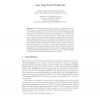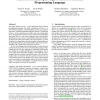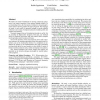42 search results - page 3 / 9 » Expressive Pointcuts for Increased Modularity |
ECOOP
2004
Springer
13 years 10 months ago
2004
Springer
Software developers create a variety of artifacts that model viour of applications at different levels of abstraction; e.g. use cases, sequence diagrams, and source code. Aspect-o...
ECOOP
2006
Springer
13 years 9 months ago
2006
Springer
Aspect-Oriented Programming (AOP) is a powerful technique to better modularize object-oriented programs by introducing crosscutting concerns in a safe and noninvasive way. Unfortu...
ICFP
2005
ACM
14 years 5 months ago
2005
ACM
This paper defines PolyAML, a typed functional, aspect-oriented programming language. The main contribution of PolyAML is the seamless integration of polymorphism, run-time type a...
AOSD
2007
ACM
13 years 9 months ago
2007
ACM
We define and study bisimulation for proving contextual equivalence in an aspect extension of the untyped lambda-calculus. To our knowledge, this is the first study of coinductive...
AOSD
2005
ACM
13 years 11 months ago
2005
ACM
C applications, in particular those using operating system level services, frequently comprise multiple crosscutting concerns: network protocols and security are typical examples ...



